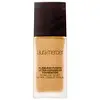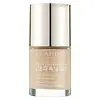What's inside
What's inside
 Key Ingredients
Key Ingredients

 Benefits
Benefits

 Concerns
Concerns

 Ingredients Side-by-side
Ingredients Side-by-side

Water
Skin ConditioningIsododecane
EmollientMethyl Trimethicone
Skin ConditioningCyclopentasiloxane
EmollientButylene Glycol
HumectantPEG-9 Polydimethylsiloxyethyl Dimethicone
EmulsifyingSilica
AbrasiveDimethicone
EmollientPhenyl Trimethicone
Skin ConditioningDisteardimonium Hectorite
StabilisingAcrylates/Dimethicone Copolymer
Skin ConditioningSodium Chloride
MaskingPhenoxyethanol
PreservativePropylene Carbonate
SolventSodium Stearoyl Glutamate
CleansingGlycerin
HumectantFarnesyl Acetate
PerfumingVp/Va Copolymer
Panthenyl Triacetate
Alcohol
AntimicrobialTocopheryl Acetate
AntioxidantPistacia Lentiscus Gum
MaskingLecithin
EmollientTitanium Dioxide
Cosmetic ColorantCI 77491
Cosmetic ColorantCI 77492
Cosmetic ColorantCI 77499
Cosmetic ColorantWater, Isododecane, Methyl Trimethicone, Cyclopentasiloxane, Butylene Glycol, PEG-9 Polydimethylsiloxyethyl Dimethicone, Silica, Dimethicone, Phenyl Trimethicone, Disteardimonium Hectorite, Acrylates/Dimethicone Copolymer, Sodium Chloride, Phenoxyethanol, Propylene Carbonate, Sodium Stearoyl Glutamate, Glycerin, Farnesyl Acetate, Vp/Va Copolymer, Panthenyl Triacetate, Alcohol, Tocopheryl Acetate, Pistacia Lentiscus Gum, Lecithin, Titanium Dioxide, CI 77491, CI 77492, CI 77499
Water
Skin ConditioningMethyl Trimethicone
Skin ConditioningDimethicone
EmollientSilica
AbrasiveCI 77891
Cosmetic ColorantAlcohol
AntimicrobialPEG-9 Polydimethylsiloxyethyl Dimethicone
EmulsifyingButylene Glycol
HumectantIsododecane
EmollientPentylene Glycol
Skin ConditioningCI 77492
Cosmetic ColorantGlycerin
HumectantPEG/PPG-18/18 Dimethicone
EmulsifyingDimethicone/PEG-10/15 Crosspolymer
Sodium Chloride
MaskingBambusa Arundinacea Stem Extract
Skin ConditioningParfum
MaskingTapioca Starch
CI 77491
Cosmetic ColorantCI 77499
Cosmetic ColorantAluminum Hydroxide
EmollientDisteardimonium Hectorite
StabilisingTriethoxycaprylylsilane
Ethylhexylglycerin
Skin ConditioningTocopheryl Acetate
AntioxidantPropylene Carbonate
SolventDisodium EDTA
Hydroxyethyl Urea
HumectantCaprylic/Capric Triglyceride
MaskingSynthetic Fluorphlogopite
Dipropylene Glycol
HumectantKalanchoe Pinnata Leaf Extract
MaskingMarrubium Vulgare Extract
Skin ConditioningAlgin
MaskingPhenoxyethanol
PreservativeSodium Citrate
BufferingCitric Acid
BufferingAcacia Senegal Gum
MaskingPhenethyl Alcohol
MaskingFurcellaria Lumbricalis Extract
Skin ConditioningSodium Benzoate
MaskingArbutus Unedo Fruit Extract
AntioxidantPotassium Sorbate
PreservativeTocopherol
AntioxidantLapsana Communis Flower/Leaf/Stem Extract
Skin ConditioningMaris Sal
Skin ConditioningWater, Methyl Trimethicone, Dimethicone, Silica, CI 77891, Alcohol, PEG-9 Polydimethylsiloxyethyl Dimethicone, Butylene Glycol, Isododecane, Pentylene Glycol, CI 77492, Glycerin, PEG/PPG-18/18 Dimethicone, Dimethicone/PEG-10/15 Crosspolymer, Sodium Chloride, Bambusa Arundinacea Stem Extract, Parfum, Tapioca Starch, CI 77491, CI 77499, Aluminum Hydroxide, Disteardimonium Hectorite, Triethoxycaprylylsilane, Ethylhexylglycerin, Tocopheryl Acetate, Propylene Carbonate, Disodium EDTA, Hydroxyethyl Urea, Caprylic/Capric Triglyceride, Synthetic Fluorphlogopite, Dipropylene Glycol, Kalanchoe Pinnata Leaf Extract, Marrubium Vulgare Extract, Algin, Phenoxyethanol, Sodium Citrate, Citric Acid, Acacia Senegal Gum, Phenethyl Alcohol, Furcellaria Lumbricalis Extract, Sodium Benzoate, Arbutus Unedo Fruit Extract, Potassium Sorbate, Tocopherol, Lapsana Communis Flower/Leaf/Stem Extract, Maris Sal
 Reviews
Reviews

Ingredients Explained
These ingredients are found in both products.
Ingredients higher up in an ingredient list are typically present in a larger amount.
Alcohol comes in many different forms. Different types of alcohol will have different effects on skin. This ingredient is usually an astringent alcohol.
These alcohols are drying on the skin. They may strip away your skin's natural oils and even damage your skin barrier. Astringent alcohols may also irritate skin.
Other types of astringent alcohols include:
According to the National Rosacea Society based in the US, you should be mindful of products with these alcohols in the top half of ingredients.
Any type of sanitizing product will have high amounts of alcohol to help kill bacteria and viruses.
Fatty alcohols come from plant oils such as coconut oil. These can help hydrate the skin and are non-irritating. Some fatty alcohols include cetyl and stearyl alcohol.
Learn more about AlcoholButylene Glycol (or BG) is used within cosmetic products for a few different reasons:
Overall, Butylene Glycol is a safe and well-rounded ingredient that works well with other ingredients.
Though this ingredient works well with most skin types, some people with sensitive skin may experience a reaction such as allergic rashes, closed comedones, or itchiness.
Learn more about Butylene GlycolCi 77491 is also hydrated iron III oxide. It's sole purpose is to give a red/pink hue to products.
Iron III oxides are classified as inorganic chemicals for coloring.
Synthetically created Ci 77491 is considered safer than those naturally found. This is because the synthetically created version may contain less impurities. Iron oxides are generally non-toxic and non-allergenic.
Learn more about CI 77491Ci 77492 is also hydrated iron III oxide. It's sole purpose is to give a yellow hue to products.
Iron III oxides are classified as inorganic chemicals for coloring.
Synthetically created Ci 77492 is considered safer than those naturally found. This is because the synthetically created version may contain less impurities. Iron oxides are generally non-toxic and non-allergenic.
Learn more about CI 77492Ci 77499 is also hydrated iron III oxide. It is created from mixing red and black iron oxides. This helps give shades of darkness to a product.
Iron III oxides are classified as inorganic chemicals for coloring.
Dimethicone is a type of synthetic silicone created from natural materials such as quartz.
What it does:
Dimethicone comes in different viscosities:
Depending on the viscosity, dimethicone has different properties.
Ingredients lists don't always show which type is used, so we recommend reaching out to the brand if you have questions about the viscosity.
This ingredient is unlikely to cause irritation because it does not get absorbed into skin. However, people with silicone allergies should be careful about using this ingredient.
Note: Dimethicone may contribute to pilling. This is because it is not oil or water soluble, so pilling may occur when layered with products. When mixed with heavy oils in a formula, the outcome is also quite greasy.
Learn more about DimethiconeDisteardimonium Hectorite comes from the clay mineral named hectorite. It is used to add thickness to a product.
It can also help stabilize a product by helping to disperse other ingredients.
Hectorite is a rare, white clay mineral.
Learn more about Disteardimonium HectoriteGlycerin is already naturally found in your skin. It helps moisturize and protect your skin.
A study from 2016 found glycerin to be more effective as a humectant than AHAs and hyaluronic acid.
As a humectant, it helps the skin stay hydrated by pulling moisture to your skin. The low molecular weight of glycerin allows it to pull moisture into the deeper layers of your skin.
Hydrated skin improves your skin barrier; Your skin barrier helps protect against irritants and bacteria.
Glycerin has also been found to have antimicrobial and antiviral properties. Due to these properties, glycerin is often used in wound and burn treatments.
In cosmetics, glycerin is usually derived from plants such as soybean or palm. However, it can also be sourced from animals, such as tallow or animal fat.
This ingredient is organic, colorless, odorless, and non-toxic.
Glycerin is the name for this ingredient in American English. British English uses Glycerol/Glycerine.
Learn more about GlycerinIsododecane is a fragrance, emollient, and solvent.
As an emollient, it helps your skin stay soft and hydrated. Emollients help trap moisture into your skin.
Isododecane's role as a solvent makes it a great texture enhancer. It spreads smoothly on skin and does not leave a sticky feeling behind. Isododecane also helps prevent color transfer in makeup products.
Isododecane is not absorbed into skin.
Learn more about IsododecaneMethyl Trimethicone is a type of silicone. It is a solvent and emulsifier.
Solvents are used to keep ingredients together in a product. They can help dissolve ingredients to stable bases or help evenly distribute ingredients throughout the product.
Emulsifiers help stabilize a product. It does this by preventing certain ingredients from separating.
Methyl Trimethicone does not get absorbed into the skin.
Learn more about Methyl TrimethiconePEG-9 Polydimethylsiloxyethyl Dimethicone is a type of silicone.
Phenoxyethanol is a preservative that has germicide, antimicrobial, and aromatic properties. Studies show that phenoxyethanol can prevent microbial growth. By itself, it has a scent that is similar to that of a rose.
It's often used in formulations along with Caprylyl Glycol to preserve the shelf life of products.
This ingredient is a solvent. It helps dissolve active ingredients and alter the texture of products.
Propylene Carbonate is commonly used in makeup and with clay, such as montmorillonite or bentonite.
Studies show this ingredient to be safe for cosmetics. When it is undiluted, it can cause skin irritation. (It is always diluted in skincare and makeup). This ingredient is water-soluble.
Propylene Carbonate is created from propylene glycol and carbonic acid.
Learn more about Propylene CarbonateSilica, also known as silicon dioxide, is a naturally occurring mineral. It is used as a fine, spherical, and porous powder in cosmetics.
Though it has exfoliant properties, the function of silica varies depending on the product.
The unique structure of silica enhances the spreadability and adds smoothness, making it a great texture enhancer.
It is also used as an active carrier, emulsifier, and mattifier due to its ability to absorb excess oil.
In some products, tiny microneedles called spicules are made from silica or hydrolyzed sponge. When you rub them in, they lightly polish away dead skin layers and enhance the penetration of active ingredients.
Learn more about SilicaChances are, you eat sodium chloride every day. Sodium Chloride is also known as table salt.
This ingredient has many purposes in skincare: thickener, emulsifier, and exfoliator.
You'll most likely find this ingredient in cleansers where it is used to create a gel-like texture. As an emulsifier, it also prevents ingredients from separating.
There is much debate on whether this ingredient is comedogenic. The short answer - comedogenic ratings don't tell the whole story. Learn more about comegodenic ratings here.
The concensus about this ingredient causing acne seems to be divided. Research is needed to understand if this ingredient does cause acne.
Scrubs may use salt as the primary exfoliating ingredient.
Learn more about Sodium ChlorideTocopheryl Acetate is AKA Vitamin E. It is an antioxidant and protects your skin from free radicals. Free radicals damage the skin by breaking down collagen.
One study found using Tocopheryl Acetate with Vitamin C decreased the number of sunburned cells.
Tocopheryl Acetate is commonly found in both skincare and dietary supplements.
Learn more about Tocopheryl AcetateWater. It's the most common cosmetic ingredient of all. You'll usually see it at the top of ingredient lists, meaning that it makes up the largest part of the product.
So why is it so popular? Water most often acts as a solvent - this means that it helps dissolve other ingredients into the formulation.
You'll also recognize water as that liquid we all need to stay alive. If you see this, drink a glass of water. Stay hydrated!
Learn more about Water